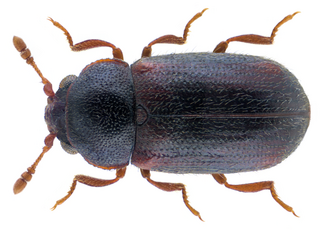
LeConte's sparrow, also known as LeConte's bunting, is one of the smallest New World sparrow species in North America.

Agathidium is a genus of beetles in the family Leiodidae.

Zopherinae is a subfamily of beetles, commonly known as ironclad beetles. Together with the subfamily Usechinae, they have been treated historically as a family, but have recently been joined by several additional taxa, making the Zopheridae a much larger composite family, and the Zopherinae are now only a small component within it, consisting of seven genera in the tribe Zopherini and one, Phellopsis in its own tribe (Phellopsini).

Moneilema, or cactus longhorn beetles are a genus of large, flightless, black beetles found in North American deserts of the western United States and northern Mexico. M. gigas is native to the Sonoran Desert at elevations below 4900 feet (1500m). The front wings of these beetles are fused forming a single, hardened shell, from which the genus derives its Latin name. The genus includes twenty species.

Cicindela, commonly known as common tiger beetles, are generally brightly colored and metallic beetles, often with some sort of patterning of ivory or cream-colored markings. They are most abundant and diverse in habitats very often near bodies of water with sandy or occasionally clay soils; they can be found along rivers, sea and lake shores, sand dunes, around dry lakebeds, on clay banks, or woodland paths.

Trox is a genus of hide beetle in the subfamily Troginae.

Eleodes is a genus of darkling beetles, in the family Tenebrionidae. They are endemic to western North America ranging from southern Canada to central Mexico with many species found along the Mexico-United States border. Some species have been introduced to Colombia. The name pinacate is Mexican Spanish, derived from the Nahuatl (Aztec) name for the insect, pinacatl, which translates as "black beetle".

Agonum is a large genus of ground beetles in the subfamily Harpalinae, tribe Platynini. They are mid-sized to smallish beetles, typically with dark metallic hues – often reddish or bronze, but sometimes black, green etc.

Altica is a large genus of flea beetles in the subfamily Galerucinae, with about 300 species, distributed nearly worldwide. The genus is best represented in the Neotropical realm, well represented in the Nearctic and Palearctic, but occurs also in the Afrotropic, Indomalaya, and Australasia. The species are similar to each other, small metallic blue-green-bronze beetles, often distinguished from each other only by the aedeagus. The species of Altica, both as larvae and as adults, are phytophagous, feeding on plant foliage of various food plant taxa, specific for each Altica species. Onagraceae and Rosaceae are the dominant host plant families for Holarctic species. The adult Altica beetles are able to jump away when approached.

Hydrochus is the only living genus of beetle in the family Hydrochidae, which belongs to the superfamily Hydrophiloidea, and was formerly treated as a subfamily of Hydrophilidae. Hydrochus includes about 180 species, which are found worldwide. The name "Hydrochus" has also been used for a fly genus in the family Dolichopodidae, but this is a junior subjective synonym of the genus Rhaphium.

Sphindidae is a family of beetles, in the suborder Polyphaga. They are called slime mold beetles due to their exclusive feeding on slime molds during adult and larval stages, other aspects of their life history are obscure. Palaeontological discoveries since 2015 have added to the geologic history of Sphindidae, including the discovery of Libanopsis, placed in the extinct subfamily Libanopsinae.

The Brachypsectridae are a family of beetles commonly known as the Texas beetles. There are only two extant genera, Brachypsectra and Asiopsectra. Brachypsectra has a cosmopolitan distribution, mostly in arid regions, while Asiopsectra is found in Central Asia and the Middle East.

Scaphinotus is a genus of beetles in the family Carabidae. There are at least 60 species, all native to North America. They eat snails and are generally limited to the moist environments where snails live. These beetles are flightless.

Xylotrechus a genus of longhorned beetles of the family Cerambycidae, containing some 200 described species.

Cyclotrachelus is a genus in the beetle family Carabidae. There are more than 40 described species in Cyclotrachelus, found in North America.
Hyboderini is a tribe of beetles in the subfamily Cerambycinae, containing the following genera and species:

Trachyderini is a tribe of long-horned beetles in the family Cerambycidae. There are at least 140 genera and 650 described species in Trachyderini.

Berosus is a genus of beetles in the family Hydrophilidae, the water scavenger beetles. The genus contains 273 species. It is distributed worldwide.

Lytta is a genus of blister beetles in the family Meloidae. There are about 70 described species in North America, and over 100 species worldwide.

Selatosomus is a genus of beetles belonging to the family Elateridae. The species of this genus are found in Europe, Japan, southern Africa and North America, and most of the species were formerly included in the genus Ctenicera.


















